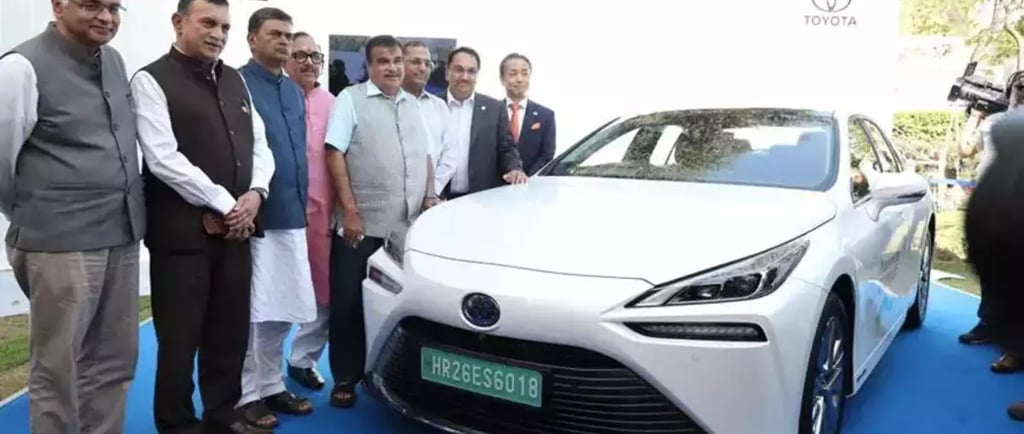Hydrogen Cars: The Zero-Emission Revolution Challenging Electric Vehicles
Explore hydrogen-powered cars: how they work, their benefits over EVs like 5-minute refueling & 300+ mile range, and the challenges of infrastructure & cost. A deep dive into the technology from Toyota Mirai to Hyundai Nexo and its future role in clean transport.
SPORT


The quest for the ultimate clean vehicle often feels like a binary choice: stick with gasoline or go electric. But quietly humming along a parallel road is a third, often misunderstood contender: the Hydrogen Fuel Cell Electric Vehicle (FCEV).
While battery electric vehicles (BEVs) have captured the public's imagination and market share, FCEVs represent a fundamentally different approach to solving the same problem. They promise the quiet, instant torque and zero tailpipe emissions of an EV, but with the familiar refueling experience and long range of a gasoline car. This isn't a futuristic fantasy; models like the Toyota Mirai and Hyundai Nexo are on roads today, offering a glimpse into a potential alternative energy future.
This deep dive goes beyond the basics to explore the intricate engineering, the real-world challenges, and the compelling use cases that make hydrogen a critical, if often overlooked, piece of the sustainable transportation puzzle.
How Does a Hydrogen Car Actually Work? The Science Simplified
At first glance, an FCEV looks like any other electric car. It has an electric motor that drives the wheels. The magic—and complexity—lies in how it generates that electricity on-demand.
The Fuel Cell Stack: The Heart of the Vehicle: This is the electrochemical engine. It takes stored hydrogen gas (H₂) from the onboard tanks and oxygen (O₂) from the ambient air.
The Chemical Reaction: Inside the fuel cell stack, hydrogen atoms are split into protons and electrons. The protons pass through a membrane, while the electrons are forced through a circuit, creating a flow of electricity.
The Only Emission: The protons, electrons, and oxygen then combine at the cathode to form the vehicle's only emission: pure water vapor (H₂O). There are no CO2, NOx, or other harmful pollutants.
The Power Buffer: This electricity either powers the motor directly or charges a small, buffer battery (much smaller than a BEV's pack). This battery also captures regenerative braking energy, improving efficiency.
In essence, an FCEV is an "electric car that makes its own electricity." You don't plug it in to charge a massive battery; you refill its tank with hydrogen gas, which it converts to power.
The Compelling Advantages: Where Hydrogen Truly Shines
The theoretical benefits of FCEVs are what drive massive investment from automakers and governments.
1. Refueling Speed and Convenience: The Game-Changer
This is hydrogen's killer feature. Filling a hydrogen tank takes 3 to 5 minutes—almost identical to filling a gas tank. This eliminates the "range anxiety" and long charging stops associated with BEVs, even with the latest ultra-fast chargers which can still take 20-30 minutes for a significant charge and can degrade battery health over time.
2. Superior Energy Density and Range
Hydrogen gas, though challenging to store, has an incredibly high energy-to-weight ratio. This allows FCEVs to achieve long ranges of 300-400 miles on a single tank without the need for monstrously heavy battery packs. This makes them ideal for drivers who lack reliable home charging, frequently take long trips, or need maximum uptime.
3. Performance in Extreme Conditions
FCEVs are less susceptible to extreme cold weather range loss than BEVs. While all vehicles see efficiency drops in the cold, a fuel cell's range reduction is generally less severe than that of a battery, which can lose 30-40% of its range in freezing temperatures.
4. Reduced Weight and Resource Pressure
The total weight of a hydrogen storage system is often less than the equivalent battery pack needed for a comparable range. This improves overall vehicle efficiency. Furthermore, FCEVs don't require the vast quantities of lithium, cobalt, and nickel needed for BEV batteries, alleviating pressure on those supply chains and associated mining concerns.
The Daunting Challenges: The Other Side of the Coin
For all their promise, FCEVs face monumental hurdles that have prevented mass adoption.
1. The Infrastructure Desert: The "Chicken-and-Egg" Problem
This is the single biggest barrier. Building a hydrogen refueling station is exponentially more complex and expensive than installing EV chargers. It requires producing, liquefying, or compressing hydrogen and transporting it via truck or pipeline. As of now, stations are almost exclusively clustered in California, parts of Germany, Japan, and South Korea. Without a widespread network, consumers won't buy the cars. Without a critical mass of cars, companies won't invest in stations.
2. The Energy Loss Conundrum: "Green" Hydrogen is Key
The environmental benefit of an FCEV is entirely dependent on how the hydrogen fuel is produced.
Grey Hydrogen: Made from natural gas (methane). This is the most common method today but produces CO2 emissions, negating much of the FCEV's clean advantage.
Blue Hydrogen: Grey hydrogen coupled with carbon capture and storage. Better, but not perfect.
Green Hydrogen: The gold standard. Produced by using renewable electricity (solar, wind) to split water molecules via electrolysis. This process is currently very expensive and accounts for a small fraction of global hydrogen production. For FCEVs to be truly clean, a massive scale-up of green hydrogen production is essential.
3. The High Cost of Technology
Fuel cell stacks, with their precious metal catalysts (like platinum), and ultra-strong, carbon-fiber hydrogen tanks are expensive to manufacture. While costs are falling, they remain significantly higher than internal combustion engines and are still competing with rapidly falling battery costs.
The Real-World Players: Who's Betting on Hydrogen?
Despite the challenges, major automotive players are making huge bets:
Toyota: The undisputed pioneer with the Mirai. Toyota is pursuing a "multi-pathway" approach, investing heavily in both hydrogen and batteries.
Hyundai: A global leader with its Nexo SUV and its XCIENT Fuel Cell heavy-duty trucks already deployed in commercial fleets in Europe and the US.
BMW: Has begun testing the iX5 Hydrogen pilot fleet and is seriously considering production models.
Stellantis: Offers hydrogen versions of its commercial vans, like the Peugeot e-Expert Hydrogen, which have a battery for city driving and a fuel cell for extended range.
The Future is Niche: Where Hydrogen Will Win First
The future of transportation is not a winner-take-all battle. Hydrogen is unlikely to replace BEVs for the average commuter. Instead, its future lies in specific, high-value niches:
Commercial Trucking and Long-Haul Transport: This is arguably hydrogen's most promising application. Trucks need long range, quick refueling, and heavy payloads. The weight of batteries for a long-haul semi is prohibitive, making hydrogen the ideal zero-emission solution.
Public Transit and Buses: Bus fleets that return to a central depot are perfect for building a single, centralized hydrogen refueling station, solving the infrastructure problem.
Aviation and Maritime Shipping: For large planes and ships, the energy density of hydrogen (or hydrogen-derived fuels) may be the only viable path to decarbonization.
Emergency and Industrial Vehicles: Where uptime is critical and vehicles can be supported by a local hydrogen supply.
